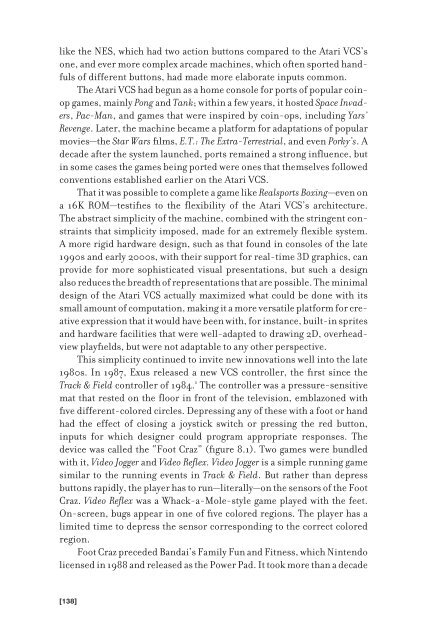Racing the Beam : the Atari Video Computer System - Index of
Racing the Beam : the Atari Video Computer System - Index of
Racing the Beam : the Atari Video Computer System - Index of
You also want an ePaper? Increase the reach of your titles
YUMPU automatically turns print PDFs into web optimized ePapers that Google loves.
like <strong>the</strong> NES, which had two action buttons compared to <strong>the</strong> <strong>Atari</strong> VCS’s<br />
one, and ever more complex arcade machines, which <strong>of</strong>ten sported handfuls<br />
<strong>of</strong> different buttons, had made more elaborate inputs common.<br />
The <strong>Atari</strong> VCS had begun as a home console for ports <strong>of</strong> popular coinop<br />
games, mainly Pong and Tank; within a few years, it hosted Space Invaders,<br />
Pac-Man, and games that were inspired by coin-ops, including Yars’<br />
Revenge. Later, <strong>the</strong> machine became a platform for adaptations <strong>of</strong> popular<br />
movies—<strong>the</strong> Star Wars fi lms, E.T.: The Extra-Terrestrial, and even Porky’s. A<br />
decade after <strong>the</strong> system launched, ports remained a strong infl uence, but<br />
in some cases <strong>the</strong> games being ported were ones that <strong>the</strong>mselves followed<br />
conventions established earlier on <strong>the</strong> <strong>Atari</strong> VCS.<br />
That it was possible to complete a game like Realsports Boxing—even on<br />
a 16K ROM—testifi es to <strong>the</strong> fl exibility <strong>of</strong> <strong>the</strong> <strong>Atari</strong> VCS’s architecture.<br />
The abstract simplicity <strong>of</strong> <strong>the</strong> machine, combined with <strong>the</strong> stringent constraints<br />
that simplicity imposed, made for an extremely fl exible system.<br />
A more rigid hardware design, such as that found in consoles <strong>of</strong> <strong>the</strong> late<br />
1990s and early 2000s, with <strong>the</strong>ir support for real-time 3D graphics, can<br />
provide for more sophisticated visual presentations, but such a design<br />
also reduces <strong>the</strong> breadth <strong>of</strong> representations that are possible. The minimal<br />
design <strong>of</strong> <strong>the</strong> <strong>Atari</strong> VCS actually maximized what could be done with its<br />
small amount <strong>of</strong> computation, making it a more versatile platform for creative<br />
expression that it would have been with, for instance, built-in sprites<br />
and hardware facilities that were well-adapted to drawing 2D, overheadview<br />
playfi elds, but were not adaptable to any o<strong>the</strong>r perspective.<br />
This simplicity continued to invite new innovations well into <strong>the</strong> late<br />
1980s. In 1987, Exus released a new VCS controller, <strong>the</strong> fi rst since <strong>the</strong><br />
Track & Field controller <strong>of</strong> 1984. 1 The controller was a pressure-sensitive<br />
mat that rested on <strong>the</strong> fl oor in front <strong>of</strong> <strong>the</strong> television, emblazoned with<br />
fi ve different-colored circles. Depressing any <strong>of</strong> <strong>the</strong>se with a foot or hand<br />
had <strong>the</strong> effect <strong>of</strong> closing a joystick switch or pressing <strong>the</strong> red button,<br />
inputs for which designer could program appropriate responses. The<br />
device was called <strong>the</strong> “Foot Craz” (fi gure 8.1). Two games were bundled<br />
with it, <strong>Video</strong> Jogger and <strong>Video</strong> Refl ex. <strong>Video</strong> Jogger is a simple running game<br />
similar to <strong>the</strong> running events in Track & Field. But ra<strong>the</strong>r than depress<br />
buttons rapidly, <strong>the</strong> player has to run—literally—on <strong>the</strong> sensors <strong>of</strong> <strong>the</strong> Foot<br />
Craz. <strong>Video</strong> Refl ex was a Whack-a-Mole-style game played with <strong>the</strong> feet.<br />
On-screen, bugs appear in one <strong>of</strong> fi ve colored regions. The player has a<br />
limited time to depress <strong>the</strong> sensor corresponding to <strong>the</strong> correct colored<br />
region.<br />
Foot Craz preceded Bandai’s Family Fun and Fitness, which Nintendo<br />
licensed in 1988 and released as <strong>the</strong> Power Pad. It took more than a decade<br />
[138]


